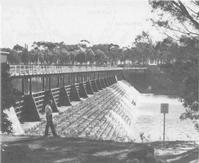


Chapter 3
I Background
II Early European Settlements
III Assessment Of Available Water Resources
IV Water Supplies For Goldmining Development
V Irrigation Development
i Channels, weirs and barrages
ii Measuring farm supplies - the Dethridge wheel
iii Early pumping schemes
iv Irrigation techniques
v Drainage of irrigated land
vi Recharge of aquifer
vii Soil-plant-water relationships
viii Carry-over storages and security of supply
VI Farm And Stock Water Supplies
VII Urban Water Supplies
VIII Wastewater Management And Treatment
IX Water Quality Management
X Limnological And Water Quality Research
XI New Techniques In Water Resource Planning And Management
XII Legislation
XIII Conclusion
XIV List Of Abbreviations
XV Acknowledgements
XVI Plantations-high Productivity Resources
References
Index
Search
Help
Contact us

Channels, weirs and barrages
Irrigation development in Australia was begun in the latter half of the 19th century, with individual farms diverting water from streams either by gravity or by pumping. There was little knowledge of the water requirements of crops and as there was no shortage of water initially the volumes applied were very much a matter of trial and error.Severe droughts in 1877-81, coupled with increasing development of inland areas in New South Wales and Victoria from the 1890s onward, led to a realization that individual water supply schemes were inadequate and should be supplemented by large-scale community projects for both irrigation and domestic and stock supplies. Techniques imported from U.S.A., U.K. and India were applied in the northern plains of Victoria, involving the construction of diversion weirs in major streams and the excavation of earthern channels to transport water over many kilometres to utilization areas.
Goulburn Weir, constructed in the period 1887-1891, across the Goulburn River near Nagambie, was a typically ambitious project of the time. This handsome structure, some 14 m high, was designed by local engineers, using the latest theory for mass-gravity dams seated on rock foundations. It was built of hand-cut granite blocks quarried several kilometres away and hauled to the site by bullock carts. It survived two major floods during construction and is still in use. It was built at a cost of $227,000. Water was transported by an earthen channel some 32 km west to the Waranga Reservoir, an off-stream storage confined by a 6.5 km long embankment, whence a main channel with an initial capacity of 31 m3/s extended westward a further 180 km for irrigation use, and an additional 195 km for domestic and stock supplies -a total distance of over 400 km, representing a project of some magnitude even by today's standards.
An interesting technical feature of these channel systems was the flat grade, employed of necessity because of the nature of the vast northern plains. For example, the Waranga Western Main channel was designed with an operating grade in its first 10 km of only 1 in 26,000. These grades were greeted with disbelief by visiting British engineers in the 1960s, but they have proved to be operationally successful, due in some measure to the low volume of silt carried in most Australian rivers compared to those in other countries.
Most of the early diversion weirs were, like Goulburn Weir, (Fig. 4) adapted from overseas design and techniques applied to local materials. Some original designs, however, were developed, one of the most notable being the Dethridge Weir, used in the River Murray at Torrumbarry and Mildura. This weir consists of a series of steel frames mounted on wheels which run on rails embedded in a concrete sill in the river bed. These trestle frames are hauled into place in periods of falling river flow and faced with timber panels to hold the upstream water pool at the desired level for diversion. The steel frames are removed from the river in flood periods.

Organisations in Australian Science at Work - Goulburn Weir, Vic.
 |
Australian Academy of Technological Sciences and Engineering |  |
© 1988 Print Edition pages 157 - 158, Online Edition 2000
Published by Australian Science and Technology Heritage Centre, using the Web Academic Resource Publisher
http://www.austehc.unimelb.edu.au/tia/155.html